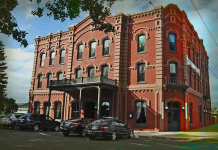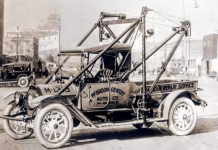Lewistown, first called Reed’s Fort for Maj. A. S. Reed, who opened the first post office in 1881, began as a small trading post on the Carroll Trail between Helena and Crow Island at the mouth of the Musselshell. When it was incorporated in 1899 the name was changed to honor a Major Lewis who in 1876 established Fort Lewis two miles to the south. Until the arrival of the Central Montana (Jawbone) R.R. in 1903, which brought homesteaders to the Judith Basin, Lewistown was merely a freighting and trading center for cattlemen and miners.
An incident of the settlement’s roaring days is related in the Journal of Granville Stuart (see notes below). Large scale rustling was causing so much trouble for central and eastern Montana that in April 1884 the Montana Stock Growers’ Association, in convention at Miles City, was forced to consider the situation. Afraid of precipitating a range war, the majority voted to take no action against the cattle thieves, despite vigorous protests from Theodore Roosevelt and the Marquis de Mores. The rustlers extended their activities. Groups of desperate ranchers united and took matters into their own hands, catching and hanging a few of the thieves.
On July 4, 1884, a couple of suspected ringleaders, Edward (Longhair) Owen and Charles (Rattlesnake Jake) Fallon, who were more villainous-looking than even their motion-picture successors, rode into town. After they had lost most of their money on a horse race, and had become very drunk, they thrashed one citizen and started to shoot up the town. Local men, armed with Winchesters, quickly took positions in stores and saloons along the single street. Rattlesnake Jake started to leave town, but, seeing Longhair wounded, fought his way back to him; the two continued firing until they could no longer pull a trigger. Rattlesnake Jake received nine wounds, Longhair eleven. Their last stand was made in front of the tent of an itinerant photographer, who photographed the bodies where they fell, to his profit. The aroused ranchers continued the clean-up until large-scale cattle thievery in Montana ended.
Lewistown is the county seat of Fergus County, Montana. Lewistown is surrounded by large cattle ranches and wheat farms and is still a major trading center.
The Croatians from Bribir near the Adriatic did much of the town’s stonework and the high quality interiors of the buildings were crafted by Norwegian and other highly skilled workers. Together, they add a distinctive, lasting imprint on the beauty of the town.
Montana Fun Facts!
The largest snowflake ever observed was 38 cm wide was recorded in Montana on January 28, 1887.
Montana holds the world record for the greatest temperature change in 24 hours. On January 14-15, 1972, the temperature went from from -45°F to 49°F a whopping 103 degrees in Loma!
At the Rocky Mountain Front Eagle Migration Area west of Great Falls more golden eagles have been seen in a single day than anywhere else in the country.
Notes:
Granville Stuart (1834-1918) was a prominent rancher and historian in Montana.
Granville Stuart was born August 27, 1834, near Clarksburg, Harrison County, West Virginia, to Robert Stuart and Nancy Currence Hall. He was the second of five children. Stuart left Iowa in 1852 with his brother James to seek a fortune in the gold fields of California. They traveled with their father, Robert Stuart, from the American Valley (Quincy) to Bidwell Bar, then on through Morris Ravine near Cherokee, finally arriving at Sam Neal’s ranch near present-day Durham. He and his brother moved up the mountain to Dogtown trying their luck in several different mining ventures. After prospecting all over northern California, Stuart eventually ended up in Montana, becoming the state’s largest cattle owner in the 1880s. A horrible freezing winter later killed his entire herd. In 1862, Stuart married Awbonnie Tookanka, and had eight children with her before her death in 1888. On June 8, 1890, he married Allis Isabelle Brown. Stuart became the state librarian for Montana and wrote several books describing his Western experiences before he died on October 2, 1918, in Butte, Montana.






